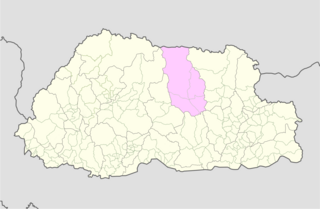
Bumthang District is one of the 20 dzongkhag (districts) comprising Bhutan. It is the most historic dzongkhag if the number of ancient temples and sacred sites is counted. Bumthang consists of the four mountain valleys of Ura, Chumey, Tang and Choekhor ("Bumthang"), although occasionally the entire district is referred to as Bumthang Valley.

Pemagatshel District is one of the 20 dzongkhags (districts) constituting Bhutan.

Bhutan, officially known as the Kingdom of Bhutan, is a landlocked country in the Eastern Himalayas. It is bordered by China to the north and India to the south. Nepal and Bangladesh are located in proximity to Bhutan but do not share a land border. The country has a population of over 754,000 and a territory of 38,394 square kilometers which ranks 133rd in terms of land area, and 160th in population. Bhutan is a constitutional monarchy with Vajrayana Buddhism as the state religion.
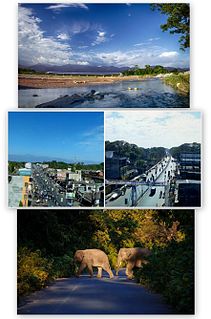
Alipurduar is a city and a municipality in the Indian state of West Bengal. It is the headquarters of the Alipurduar district. Situated on the east bank of Kaljani River on the foothills of the Himalayas, the city is a gateway to Bhutan and northeastern states of India. Alipurduar was a sub-divisional town of Jalpaiguri district. On 25 June 2014, Smt. Mamata Banerjee, the Hon’ble Chief Minister, GoWB, declared Alipurduar as the 20th district of West Bengal.

A gewog, in the past also spelled as geog, refers to a group of villages in Bhutan. The head of a gewog is called a gup. Gewogs form a geographic administrative unit below dzongkhag districts, and above Dzongkhag Thromde class B and Yenlag Thromde municipalities. Dzongkhag Thromde class A municipalities have their own independent local government body.

Jaigaon is a census town in Alipurduar subdivision of Alipurduar district in the state of West Bengal, India. It is located on the country's border with Bhutan. The main overland entrance to Bhutan is through Jaigaon and Bhutan Gate separates the two countries. Phuentsholing is the Bhutan's nearest city to Jaigaon. Bhutan does not have domestic roads linking to all its towns, so Bhutan uses Indian roads passing through Jaigaon to reach such destinations as Samtse, Gomtu, Nganglam and Samdrup Jongkhar.
The official religion in Bhutan is Vajrayana Buddhism, which is practiced by 75% of the population. Bhutan is a Buddhist country by constitution and Buddhism plays a vital role in the country. Buddhism is the cultural heritage of Bhutan and its people's identity as well. Freedom of religion is guaranteed by the King. Approximately 75 percent of the population of 770,000 follow either the Drukpa Lineage of the Kagyu school, the Nyingma school of Tibetan Buddhism or another school of Buddhism. The remaining 25 percent, mainly Lhotshampas, practice Hinduism.

There are two dozen languages of Bhutan, all members of the Tibeto-Burman language family except for Nepali, which is an Indo-Aryan language, and Bhutanese Sign Language. Dzongkha, the national language, is the only language with a native literary tradition in Bhutan, though Lepcha and Nepali are literary languages in other countries. Other non-Bhutanese minority languages are also spoken along Bhutan's borders and among the primarily Nepali-speaking Lhotshampa community in South and East Bhutan.
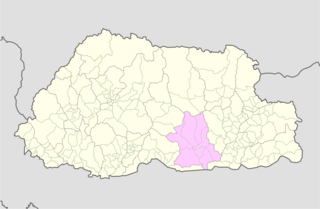
Ngangla Gewog is a gewog of Zhemgang District, Bhutan, bordering India. Ngangla Gewog is also a part of Panbang Dungkhag (sub-district), along with Goshing, Bjoka, and Phangkhar Gewogs.
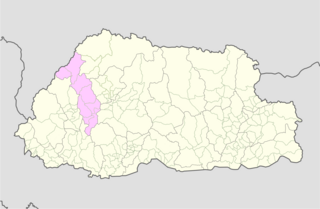
Kawang Gewog is a gewog of Thimphu District, Bhutan.As of 2005 it has a population of 2582 and covers an area of 307 square kilometres.

Dorona Gewog is a gewog of Dagana District, Bhutan. It also comprises part of Dagapela Dungkhag, along with Goshi and Tashiding Gewogs.

Drujegang Gewog is a gewog of Dagana District, Bhutan. Drukgyegang is one of the villages of the district.

Chali Gewog is a gewog of Mongar District, Bhutan. In 2002, the gewog contained 263 households and covered an area of 42 square kilometres.

Orong Gewog is a gewog of Samdrup Jongkhar District, Bhutan. It is situated north of Samdrup Jongkhar town. The Gewog is about 45 km from Samdrup Jongkhar with a 12 km Gewog Center (GC) road bifurcating from the national highway at Shekpashing which connects Samdrup Jongkhar and Trashigang District.
Kangpar Gewog is a gewog of Trashigang District, Bhutan. Kangpara Gewog, along with Thrimshing Gewog, comprises Thrimshing Dungkhag (sub-district). Kangpara is one of the remotest gewogs under Trashigang Dzongkhag (district). The gewog is 341.9 square kilometers and shares borders with other gewogs like Gomdar, Thrimshing, Shongphu, Khaling, Shingkhar Lauri and Merak. Kangpara is popular for housing some sacred monasteries like Lamai Goenpa, Sikhar Goenpa et al., and is also popular for their belief in deities like Ama Jomo and Meme Dangling.

ʼOle, also called ʼOlekha or Black Mountain Monpa, is a Sino-Tibetan language spoken by about 1,000 people in the Black Mountains of Wangdue Phodrang and Trongsa Districts in western Bhutan. The term ʼOle refers to a clan of speakers.

Khamdang Gewog is a gewog of Trashiyangtse District, Bhutan.
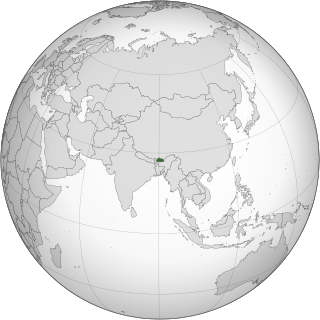
Typical format for telephone numbers in Bhutan are: +975 XX XXXXXX (mobile) and +975 X XXXXXX.

The cinema of Bhutan is a small but emerging industry, having started in the mid-1990s. It has since been supported by government officials and different businesses.

















